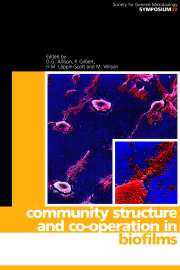Book contents
- Frontmatter
- Contents
- Contributors
- Editors' Preface
- An overview of biofilms as functional communities
- Initial microbial adhesion events: mechanisms and implications
- Physiological events in biofilm formation
- Environmental and genetic factors influencing biofilm structure
- Coaggregation and coadhesion in oral biofilms
- Cohesiveness in biofilm matrix polymers
- Microbial detachment from biofilms
- Modelling and predicting biofilm structure
- Microbial community interactions in biofilms
- Microbial communities: aggregates of individuals or co-ordinated systems
- Gene transfer in biofilms
- Population dynamics in microbial biofilms
- Biodegradation by biofilm communities
- Biofilms and prosthetic devices
- Biofilms: problems of control
- Biofilms in the New Millennium: musings from a peak in Xanadu
- Index
Initial microbial adhesion events: mechanisms and implications
Published online by Cambridge University Press: 03 June 2010
- Frontmatter
- Contents
- Contributors
- Editors' Preface
- An overview of biofilms as functional communities
- Initial microbial adhesion events: mechanisms and implications
- Physiological events in biofilm formation
- Environmental and genetic factors influencing biofilm structure
- Coaggregation and coadhesion in oral biofilms
- Cohesiveness in biofilm matrix polymers
- Microbial detachment from biofilms
- Modelling and predicting biofilm structure
- Microbial community interactions in biofilms
- Microbial communities: aggregates of individuals or co-ordinated systems
- Gene transfer in biofilms
- Population dynamics in microbial biofilms
- Biodegradation by biofilm communities
- Biofilms and prosthetic devices
- Biofilms: problems of control
- Biofilms in the New Millennium: musings from a peak in Xanadu
- Index
Summary
INTRODUCTION
In most textbooks, biofilm formation on surfaces has been depicted as a sequence of events. Depending on the particular interest of the author, these events are split up into four or more steps (Escher & Characklis, 1990; Van Loosdrecht et al., 1990). The sequence is presented in Fig. 1. Traditionally, biofilm formation is said to begin with mass transport of micro-organisms towards a substratum surface (Fig. 1b), but in almost all environments, the mass transport step is preceded by the adsorption of conditioning film components (Fig. 1a), such as: an adsorbed tear film on a contact lens (Baguet et al., 1995; Landa et al., 1998); the salivary pellicle on surfaces in the oral cavity (Busscher et al., 1989; Bradshaw et al., 1997); a film of adsorbed urinary components on urogenital surfaces (Reid et al., 1998); and adsorbed macromolecules on marine surfaces (Schneider & Marshall, 1994). Many more examples of the formation of a film conditioning a surface as the first step in biofilm formation can be given. Once transported to a substratum surface, organisms may or may not adhere, depending on the interaction forces (Rutter & Vincent, 1980). This initial adhesion (Fig. 1c) is generally reversible (Norde & Lyklema, 1989), but even in the absence of exopolymer production, becomes less reversible within minutes due to the progressive removal of water from in-between the interacting surfaces (Meinders et al., 1995). The unfolding of binding molecules and other non-metabolic mechanisms eventually lead to the strong anchoring of the initially adhering organisms (Fig. 1e). At this stage, there is often a neglected step which occurs almost simultaneously, that is, coadhesion (Fig. 1d).
- Type
- Chapter
- Information
- Community Structure and Co-operation in Biofilms , pp. 25 - 36Publisher: Cambridge University PressPrint publication year: 2000
- 17
- Cited by



